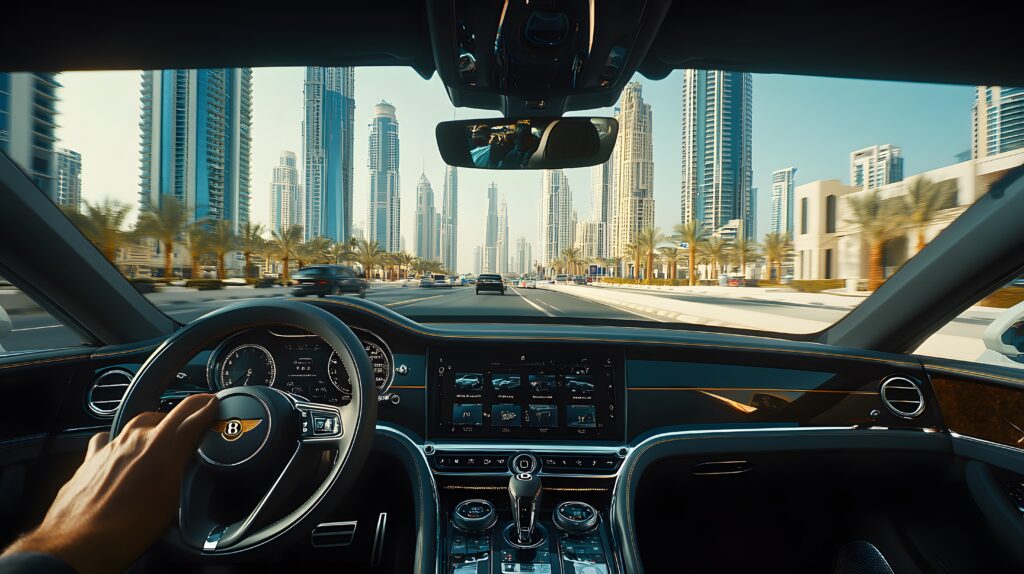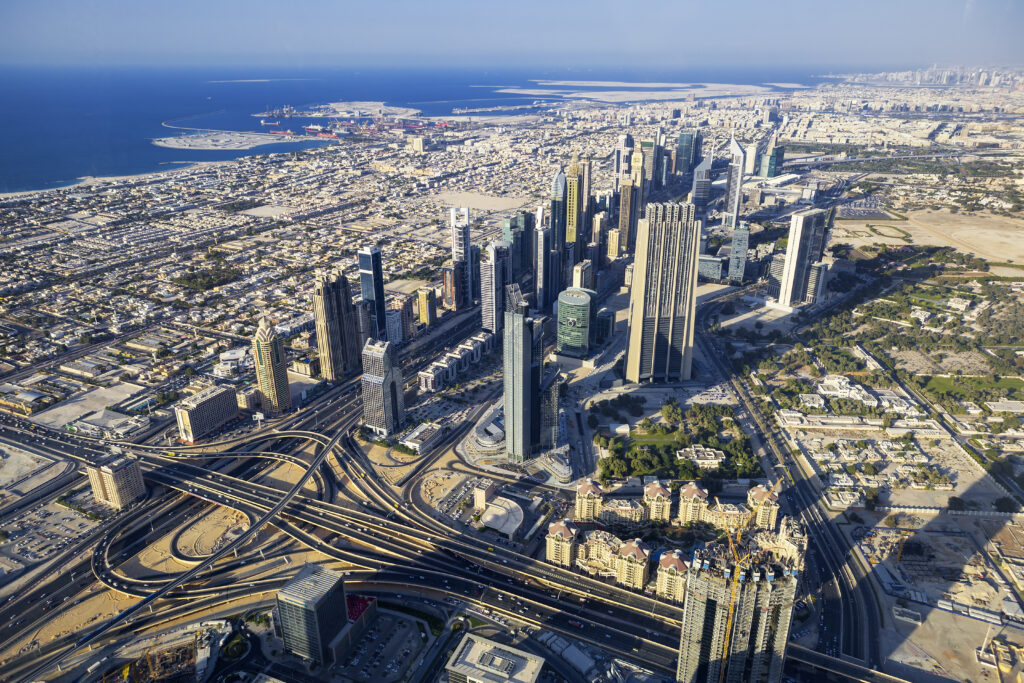If your adventures take you to the glittering streets of Dubai, experiencing the city behind the wheel is a must. Dubai’s world-class roads and perfectly designed infrastructure make driving not just a necessity, but a pleasure. From the towering skyline along Sheikh Zayed Road to the winding streets of historic neighborhoods, navigating the city by car offers an unmatched perspective. However, for expats, tourists, and new residents, driving in Dubai can come with its own set of challenges.
To take the stress out of your experience and help you feel confident on every kilometer, this guide covers everything you need to know—from Dubai’s road rules to essential driving tips.
Driving Rules and Regulations in Dubai
Dubai’s roads are engineered to perfection—but keeping them safe and efficient relies on strict traffic laws. Familiarizing yourself with these rules should be your first step.
General Guidelines
- Drive on the right. In Dubai, vehicles drive on the right-hand side of the road. Always overtake from the left and use indicators for lane changes to stay safe.
- Seat belts are mandatory. All passengers, including those in the backseat, must wear seat belts. Not wearing one can result in fines, as road safety is taken seriously.
- No drinking and driving. Dubai has a strict 0% blood alcohol limit. Even a small amount can lead to hefty fines, license suspension, or jail time. Plan alternative transport if you plan to drink.
- Avoid distractions. Using a phone or gadgets while driving is illegal unless hands-free. Stay focused and avoid texting to prevent accidents.
- Keep a safe distance. Dubai’s fast traffic often leads to sudden stops. Maintain at least a 5-second gap to avoid rear-end collisions.
- Give way to emergency vehicles. Always make way for ambulances, fire trucks, or police cars with flashing lights. Move aside or stop if needed, and never block or tailgate them.
Speed Limits
Dubai operates a modern traffic monitoring system, so speed cameras are ubiquitous. Always adhere to the speed limits, which are strictly enforced.
- Highways: 100–120 km/h (60–75 mph)
- Urban streets and major roads: 60–80 km/h (40–50 mph)
- Suburban or residential areas: 40 km/h (25 mph)
Pro tip: The speed limits on some highways allow vehicles a 20 km/h leeway above the listed speed. Watch out for signs and adjust your speed accordingly.
Navigation Tips
For newcomers, hopping from lane to lane in Dubai can be overwhelming. Practice these simple habits to minimize confusion and maintain safety.
- Passing: Always pass from the left. Check your mirrors, do a shoulder check, and use indicators before changing lanes.
- Turning: Observe traffic signs. Do not make right turns at red traffic lights unless explicitly allowed.
- Parking: Parking along black and yellow curbs is prohibited. Use designated paid parking areas, which can be found throughout the city center or in parking garages. A mobile app will alert you before your paid parking expires.
Right of Way

Understanding right-of-way rules will help you avoid unnecessary stress or fines. Dubai’s system is straightforward and aims to prioritize safety.
- Yield at pedestrian crossings.
- Give way to emergency vehicles, military convoys, and buses.
- At T-junctions, vehicles on the major road always have the right of way.
- Respect roundabout etiquette by yielding to vehicles already inside.
Keep an eye out for school buses with flashing lights. Drivers must stop behind the bus as children board or alight.
Toll Roads in Dubai
Several key highways in Dubai have tolls, collectively managed under the “Salik” system. The process, however, is entirely electronic.
- Toll Roads Include:
- Sheikh Zayed Road
- Al Garhoud Bridge
- Al Maktoum Bridge
- Beirut Street
- Al Ittihad Street
To use these, you’ll need a Salik tag affixed to your windshield. Tolls are automatically deducted as you pass through gates. Salik tags can be purchased at most gas stations.
Rental Car Essentials
For tourists and expats without vehicles, renting a car in Dubai is easy and convenient, offering the freedom to explore the city and beyond at your own pace. Whether you’re after luxury cars like Lamborghinis or budget-friendly options, Dubai has you covered.
Here’s what you need to know:
- You’ll need an international driving permit (IDP) and your home country’s license to legally rent and drive in the UAE. Make sure they’re valid during your stay.
- Most rental companies require drivers to be at least 21 or 25 years old, depending on the car. Luxury or sports cars often have a higher age requirement, usually starting at 30.
- Always carry proof of registration, insurance, and ID when driving, as authorities may request them during checks or in case of an accident.
Carasti offers flexible short-term and long-term options, with online booking available. Whether you’re planning a road trip to the desert or navigating city streets, a rental car can make your trip smoother and more enjoyable.
Choosing Your Ride: Taking on dunes or highways? SUVs with all-wheel drive are ideal for desert adventures, but sedans are better suited for city driving. No matter the choice, a GPS add-on will make navigation a breeze.
Emergency Contacts and Safety Tips
Safety is paramount when driving in any new city, and Dubai is no exception. Whether you’re a tourist or a resident, being prepared for emergencies can make all the difference. Save these important emergency numbers and apps to ensure you’re ready for any situation: .
- Police: Call 999 or 112 for any law enforcement or emergency assistance.
- Ambulance: Dial 998 or 112 for medical emergencies to ensure prompt care.
- Fire Department: Contact 997 or 112 in case of fire-related incidents.
For faster medical assistance, consider downloading the DCAS SOS app. This app uses GPS technology to locate you and dispatch ambulances as quickly as possible, providing critical support when every second counts.
If you experience a car breakdown, always prioritize your safety by pulling over to the shoulder and turning on your hazard lights to warn other drivers. It’s also a good idea to have the contact details of your rental agency or local roadside assistance providers stored in your phone in case you need immediate help. Remember, being prepared and knowing these details can help you navigate any unexpected situations with confidence.
Being a Responsible Driver in Dubai
Driving in Dubai combines efficiency, innovation, and excitement. With world-class infrastructure, wide highways, and well-maintained roads, getting around is seamless. Whether cruising along Sheikh Zayed Road with its stunning skyline or visiting Hatta Heritage Village for a taste of traditional Emirati culture, every drive showcases the city’s grandeur and diversity.
To enjoy Dubai’s roads while contributing to smooth traffic flow:
- Avoid tailgating, even in slow traffic, to ensure everyone’s safety.
- Be patient, especially in busy areas like Downtown Dubai or the Marina.
- Use navigation apps like Google Maps or Waze for real-time updates on lane closures, roadworks, or accidents to plan your route effectively.
Whether you’re a local or visitor, driving in Dubai is about following these tips and enjoying the journey. Respecting road rules ensures a memorable experience for everyone.
Discover Dubai Behind the Wheel

Driving in Dubai is more than just getting around; it’s your gateway to discovering everything this incredible city has to offer. From the iconic Burj Khalifa to the stunning Palm Jumeirah, the open road showcases a whole new side of the UAE.
Make your Dubai journey even smoother with Carasti! Whether you’re a traveler or new resident, Carasti offers flexible car subscriptions so you can hit the road hassle-free. No long-term commitments, no stress, just pick your car and drive.
Now that you’ve got these tips and Carasti at your side, share them with others and enjoy safe, happy exploring!
